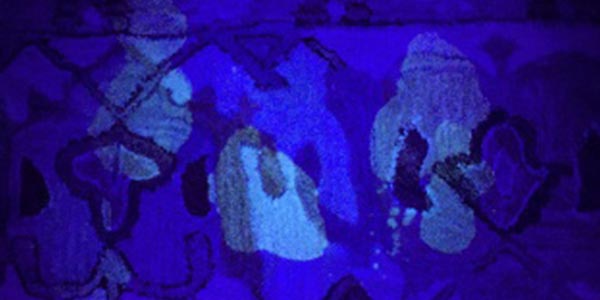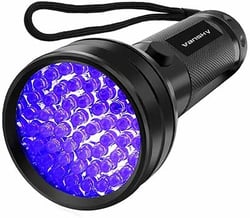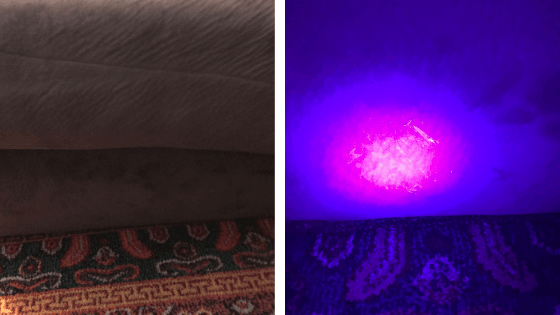
Despite your best efforts, sometimes your dog’s potty training may not be going exactly according to plan.
If your dog isn’t always making it outside to potty, pee stains and odors can be lurking in your carpets.
You may not even know that your dog is secretly going potty in your home until you smell a hint of pee.
How do you know if your dog has been having accidents indoors?
Use a Blacklight to Find Urine Stains!
If there are no smells or your dog isn’t repeatedly marking one area, it doesn’t mean you’re in the clear. Rather than putting your nose to the floor trying to discover where that smell is coming from, you can find dried urine stains on carpet and furniture with a blacklight. Unleash your inner scientist and scan the light on your floors to find the stains.
Wavelengths in a blacklight cause phosphorous and proteins in the urine to glow, making it easier to spot old stains. Pet stains that weren't cleaned properly with an enzyme-based cleaner will show up under UV light as well.

This UV flashlight is less expensive, however, the wavelength from this UV Blacklight Torch (365–370nm) is more effective — but it's a pricey gadget.
FYI: The greater the wavelength, the better visibility for fluorescing proteins in urine. Both of these lights will work, but the less expensive light will typically only work in a very dark room.
This video is about how to find cat urine using a blacklight, but the process is the same for dog urine.
Pro-Tip: A blacklight works best the darker the room is. Try to do your searching at night, unless you’ve got good blackout curtains or other means of really darkening a room during the day.
Where to Search for Lingering Urine Stains
You can’t always see pee stains, especially on dark carpet, and smells from pee stains left on the carpet can cause your dog to repeatedly mark that spot. If you’re curious if your dog has been having accidents, here are some places you can start your search:
- Where you've caught your dog having accidents before
- Behind curtains
- Near entry doors
- Dark corners
- On and around their bed
- Under their crate
- Next to indoor plants
Pro-Tip: Check the walls and furniture for splatters next to any stains you find, like shown in the photo below (especially true if you have a male dog).

What You Should Do After You Find Urine Stains?
Once you’ve found the urine stains, it’s time to clean them up with an enzyme-based cleaner that will neutralize the odors and remove the stain. Use our tips and recommended cleaners for cleaning up potty accidents to make sure you only have to do this once.
Pro-Tip: When moving into a new home, it can be helpful to use a blacklight to see if there are any messes that the previous tenant or homeowner didn’t clean properly to prevent your dog from having accidents in the same places.
Don’t have a blacklight handy, but want to check your floors? Check out this “hack” for turning your iPhone flashlight into a makeshift blacklight:
If you’ve found and cleaned the urine spots on your floors and your dog is still having accidents inside, your dog may have a medical issue, like diabetes, Cushing’s disease, kidney dysfunction, or a urinary tract infection (UTI), that could be making it more difficult to not go potty indoors. If you have concerns, always consult your veterinarian.
Not All that Glows is Dog Pee!
When exposed to ultraviolet beams of black light, lots of things will glow white, green, blue, orange, or even red. While dog pee glows under this type of light, so will liquids and other liquid-like substances, such as some laundry detergents, milk, honey, canola or olive oil, ketchup, tonic water, and antifreeze. Blacklight is also used to detect molds and fungi, including some of the fungi species that cause ringworm.
Want to experiment with a black light on some fun things in your home? Try lighting these up: cotton balls, brown spots on banana peels, some flowers, B-vitamins, and newer US currency over $5 (they have fluorescent bands to prove they’re not counterfeit).




